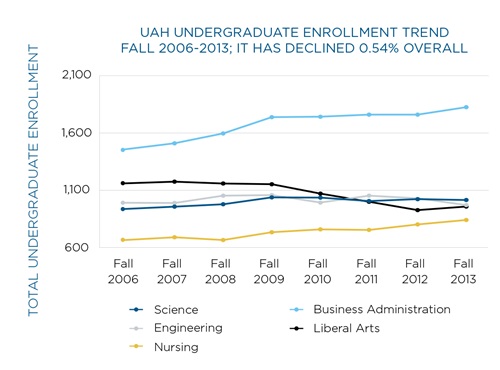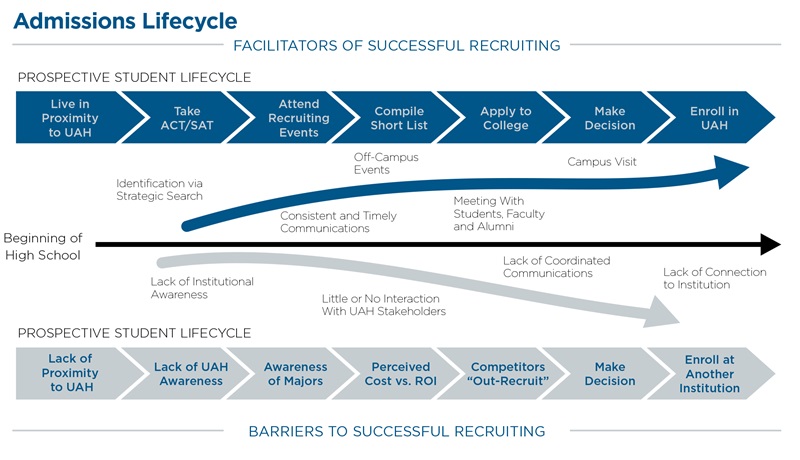The Opportunity
The University of Alabama in Huntsville (UAH) is a midsize public institution in northern Alabama primarily known for its colleges of science and engineering. UAH also has colleges of business, nursing, liberal arts and the recently established Honors College. UAH has a strong history of research and is categorized by the Carnegie Foundation as a “very high research activity” university, drawing on the historic strengths of the aeronautical and high-tech industries in and around Huntsville. With about 7,700 students, UAH is the 8th largest (measured by FTE) of the 14 public universities in Alabama.
UAH partnered with Huron to develop a plan to help the university achieve its enrollment goals: 10,000 students by 2020, an increased proportion of full-time students, increasing demographic and socio-economic diversity, and a higher academic profile for new full-time freshmen.
Freshmen enrollment had remained essentially flat for the previous eight years while the institution experienced a shrinking geographic footprint. UAH had become increasingly reliant on students from the surrounding four-county area while other competing public institutions had increased their presence throughout the region and state. Attempts to recruit students from central and southern Alabama, as well as across the Southeast, did not yield the number of students UAH had hoped they would.
UAH asked Huron to assess the operations of the Enrollment Management division, as well as the institution’s communication materials and plan for outreach to students, and to develop a comprehensive enrollment management model consistent with Huron’s strategic enrollment alignment framework.
The Approach
Huron utilized a combination of conversations with key institutional stakeholders, in-depth market analysis to identify emerging market trends and primary market research of prospective students to identify four areas where UAH would need to focus efforts:
- Develop a data-driven, articulated plan and strategy to meet its growth targets.
- Create a single, clear and unifying institutional identity.
- Embrace enrollment management as an institutional strategy with shared ownership, rather than just being the role of one unit.
- Enhance the structure of enrollment leadership and functions to allow for better coordination and management of the student lifecycle.
Huron catalogued and analyzed the university’s student marketing efforts: all printed materials, the university website, e-mail communications and social media.
Huron found that each college within the university utilized its own design format, and each had independent strategies for reaching out to prospective students. Marketing materials did not exhibit common institutional themes or descriptors that are needed for successfully branding and marketing a university. As part of this analysis, Huron helped the university identify unique attributes that differentiate UAH in the marketplace.
Huron further analyzed the characteristics of historic university applicants, as well as results from a survey of prospective students administered by Huron’s constituent research experts. Huron found that, despite UAH’s strong academic credentials, it has experienced difficulty in carving a market niche that differentiates the university among the 13 other public four-year institutions in Alabama, including dominant competitors like the University of Alabama at Tuscaloosa and Auburn University. In many ways, UAH had become the de facto choice for local students only; about 90% of its students live within 100 miles of campus. Huron learned that students beyond the 100 mile radius of campus had little to no knowledge of the institution.
In analyzing UAH’s operations, the market and emerging trends, and aggregating real-time prospective student market data, Huron helped UAH understand:
- How it is perceived and positioned in the marketplace among prospective students and key competitors.
- How to focus recruiting efforts in new or underserved state and regional recruiting markets.
- How to create a more identifiable and unique niche in the crowded university marketplace.
- How to communicate its value and brand proposition to prospective students.
Marketplace perception: UAH is perceived as a rigorous academic institution for serious students, especially those who want to pursue a degree in UAH’s strong STEM (science, technology, engineering and mathematics) fields. Huron’s market research and prospective student surveys found that many prospective students knew little about the institution. Another key finding was that UAH was starting the recruiting process too late in the decision-making process. By the time UAH began recrutiing, most of the top prospective students had already decided the list of institutions to which they intended to apply.
New potential markets for students: Huron identified several potential markets throughout Alabama and the Southeast where UAH should increase its recruiting efforts. For example, UAH has not systematically recruited students from Alabama’s populous and relatively affluent counties where many college-bound high school graduates are better prepared for the rigor of UAH’s STEM programs. Nor had the university taken full advantage of marketing a multi-state cooperative that allows students to attend UAH and pay in-state tuition if it offers a program that is not available in the student’s home state.
Huron also advised UAH to set up differentiated recruitment plans or materials by student type (e.g., transfer students, high school freshmen, inquiry source). By creating multi-channel, multi-message recruiting plans, UAH will broaden its reach while simultaneously presenting a unified value proposition.
Creating a marketing niche: Huron’s research found a number of attributes that allow UAH to differentiate itself from competitors:
- UAH is the smallest public Research 1 university in the nation, meaning students can participate in cutting edge research while also having access to faculty members who are carrying out that research. Those attributes and others allow UAH to boldly refer to itself as having “private school size at a public school price.”
- The proximity of UAH to the area’s many high-tech companies and research park — and UAH’s co-op program, which places students in jobs with local companies directly related to their field of study — provides students an advantage in the job market.
- UAH graduates have the highest average starting salaries of all public universities in Alabama. Put another way, the return on investment of a UAH degree is higher than at its competitors.
The Results
UAH is focused on implementing Huron’s recommendations:
- Reviewing organizational structure and implementing recommendations to better align enrollment management functions
- Increasing knowledge of enrollment management and shared ownership of student lifecycle management throughout the institution
- Revisiting marketing efforts and committing resources to strategic student outreach
- Streamlining financial aid processes and better communicating that information to students
- Increasing understanding of how and when to use data to make evidence-based decisions



